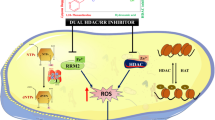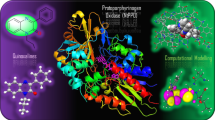Abstract
Two zinc(II) terpyridine complexes Zn(atpy)2(PF6)2 (1) (atpy = 4′-p-N9′-adeninylmethylphenyl-2,2′:6,2′′-terpyridine) and Zn(ttpy)2(PF6)2 (2) (ttpy = 4′-p-tolyl-2,2′:6,2′′-terpyridine) have been synthesized and characterized by elemental analysis, 1H NMR and electrospray mass spectroscopy. The structure of complex 2 was also determined by X-ray crystallography, which revealed a ZnN6 coordination in an octahedral geometry with two terpyridine acting as equatorial ligands. The circular dichroism data showed that complex 1 exhibited an ICD signal at around 300 nm and induced more evident disturbances on DNA base stacking than complex 2, reflecting the impact of the adenine moiety on DNA binding modes. Complex 1 exhibited higher cleavage activity to supercoiled pUC 19 DNA than complex 2 under aerobic conditions, suggesting a promotional effect of adenine moiety in DNA nuclease ability. Interestingly, both complexes demonstrated potent in vitro cytotoxicity against a series human tumor cell lines such as human cervix carcinoma cell line (HeLa), human liver carcinoma cell line (HepG2), human galactophore carcinoma cell line (MCF-7) and human prostate carcinoma cell line (pc-3). The cytotoxicity is averagely 10 times more active than the anticancer drug cisplatin.






Similar content being viewed by others
References
Berova N, Nakanishi K, Woody RW (2000) In circular dichroism: principles and applications, 2nd edn part II. Wiley, Chichester, p 748
Choi C-F, Tsang P-T, Huang J-D, Chan EYM, Ko W-H, Fong W-P et al (2004) Synthesis and in vitro photodynamic activity of new hexadeca-carboxy phthalocyanines. Chem Commun (Camb) 2236–2237. doi:10.1039/b405868b
Glover PB, Ashton PR, Childs LJ, Rodger A, Kercher M, Williams RM et al (2003) Hairpin-shaped heterometallic luminescent lanthanide complexes for dna intercalative recognition. J Am Chem Soc 125:9918–9919. doi:10.1021/ja029886s
Hannon MJ (2007) Supramolecular DNA recognition. Chem Soc Rev 36:280–295. doi:10.1039/b606046n
Haq I, Ladbury J (2000) Drug-DNA recognition: energetics and implications for design. J Mol Recognit 13:188–197. doi:10.1002/1099-1352(200007/08)13:4<;188::AID-JMR503>;3.0.CO;2-1
Harvey MA, Baggio S, IbanÄezd A, Baggioe R (2004) Three zinc(II) complexes presenting a ZnN6 chromophore and with peroxodisulfate as the counter-ion. Acta Cryst C60:m375–m381
Holder A, Swavey S, Brewer KJ (2004) Design aspects for the development of mixed-metal supramolecular complexes capable of visible light induced photocleavage of DNA. Inorg Chem 43:303–308. doi:10.1021/ic035029t
Jiang Q, Xiao N, Shi P, Zhu Y, Guo Z (2007) Design of artificial metallonucleases with oxidative mechanism. Coord Chem Rev 251:1951–1972. doi:10.1016/j.ccr.2007.02.013
Jiang Q, Wu Z, Zhang Y, Hotze ACG, Hannon MJ, Guo Z (2008) Effect of adenine moiety on DNA binding property of copper(II)–terpyridine complexes. Dalton Trans 3054–3060. doi:10.1039/b719010g
Johansson O, Borgstroem M, Lomoth R, Palmblad M, Bergquist J, Hammarstroem L et al (2003) Electron donor–acceptor dyads based on ruthenium(ii) bipyridine and terpyridine complexes bound to naphthalenediimide. Inorg Chem 42:2908–2918. doi:10.1021/ic020420k
Juranović I, Meić Z, Piantanida I, Tumir L-M, Žinić M (2002) Interactions of phenanthridinium–nucleobase conjugates with polynucleotides in aqueous media. Recognition of poly U. Chem Commun (Camb) 1432–1433. doi:10.1039/b202615e
Kovala-Demertzi D, Yadav PN, Wiecek J, Skoulika S, Varadinova T, Demertzis MA (2006) Zinc(II) complexes derived from pyridine-2-carbaldehyde thiosemicarbazone and (1E)-1-pyridin-2-ylethan-1-one thiosemicarbazone. Synthesis, crystal structures and antiproliferative activity of zinc(II) complexes. J Inorg Biochem 100:1558–1567. doi:10.1016/j.jinorgbio.2006.05.006
Levine LA, Morgan CM, Ohr K, Williams ME (2005) Tetraplatinated artificial oligopeptides afford high affinity intercalation into dsDNA. J Am Chem Soc 127:16764–16765. doi:10.1021/ja055162f
Li CK-L, Sun RW-Y, Kui SC-F, Zhu N, Che C-M (2006) Anticancer cyclometalated [AuIIImACHTUNGTRENUNG(C^N^C)mL]n+compounds: synthesis and cytotoxic properties. Chem Eur J 12:5253–5266. doi:10.1002/chem.200600117
Martelli A, Constant J-F, Demeunynck M, Lhomme J, Dumy P (2002) Design of site specific DNA damaging agents for generation of multiply damaged sites. Tetrahedron 58:4291–4298. doi:10.1016/S0040-4020(02)00345-9
Nejedlý K, Chládková J, Vorlíčková M, Hrabcová I, Kypr J (2005) Mapping the B-A conformational transition along plasmid DNA. Nucleic Acids Res 33(1):e5. doi:10.1093/nar/gni008
Neve F, Crispini A, Campagna S, Serroni S (1999) Synthesis, structure, photophysical properties, and redox behavior of cyclometalated complexes of iridium(iii) with functionalized 2, 2¢-bipyridines. Inorg Chem 38:2250–2258. doi:10.1021/ic981308i
Novakova O, Kasparkova J, Vrana O, van Vliet PM, Reedijk J, Brabec V (1995) Correlation between cytotoxicity and DNA binding of polypyridyl ruthenium complexes. Biochemistry 34:12369–12378. doi:10.1021/bi00038a034
Sheldrick GM (1997) SHELX-97, A computer program for crystal structure solution and refinement. University of Göttingen (Germany)
Sheldrick GM (2001) SADABS, Version 2, Multi-Scan absorption correction program. University of Göttingen (Germany)
Shi P, Jiang Q, Zhao Y, Zhang Y, Lin J, Lin L et al (2006) DNA binding properties of novel cytotoxic gold(III) complexes of terpyridine ligands: the impact of steric and electrostatic effects. J Biol Inorg Chem 11:745–752. doi:10.1007/s00775-006-0120-y
Srivatsan SG, Parvez M, Verma S (2002) Modeling prebiotic catalysis with adenylated polymeric templates: crystal structure studies and kinetic characterization of template-assisted phosphate ester hydrolysis. Chem Eur J 8:5184. doi:10.1002/1521-3765(20021115)8:22<5184::AID-CHEM5184>3.0.CO;2-2
Steiner T (1996) C–H···O hydrogen bonding in crystals. Crystallogr Rev 6:1–57. doi:10.1080/08893119608035394
Szaciłowski K, Macyk W, Drzewiecka-Matuszek A, Brindell M, Stochel G (2005) Bioinorganic photochemistry: frontiers and mechanisms. Chem Rev 105:2647–2694. doi:10.1021/cr030707e
Tumir L-M, Piantanida I, Juranović Cindrić I, Hrenar T, Meićand Z, Žinić M (2003) New permanently charged phenanthridinium–nucleobase conjugates. Interactions with nucleotides and polynucleotides and recognition of ds-polyAHt. J Phys Org Chem 16:891–899. doi:10.1002/poc.680
Tumir L-M, Piantanida I, Juranović I, Meić Z, Tomić S, Žinić M (2005) Recognition of homo-polynucleotides containing adenine by a phenanthridinium bis-uracil conjugate in aqueous media. Chem Commun (Camb) 2561–2563. doi:10.1039/b500617a
Acknowledgments
We thank the National Natural Science Foundation of China and the Natural Science Foundation for Colleges and Universities in Jiangsu province (07KJD320013) for financial supports.
Author information
Authors and Affiliations
Corresponding author
Electronic supplementary material
Below is the link to the electronic supplementary material.
Rights and permissions
About this article
Cite this article
Jiang, Q., Zhu, J., Zhang, Y. et al. DNA binding property, nuclease activity and cytotoxicity of Zn(II) complexes of terpyridine derivatives. Biometals 22, 297–305 (2009). https://doi.org/10.1007/s10534-008-9166-3
Received:
Accepted:
Published:
Issue Date:
DOI: https://doi.org/10.1007/s10534-008-9166-3




